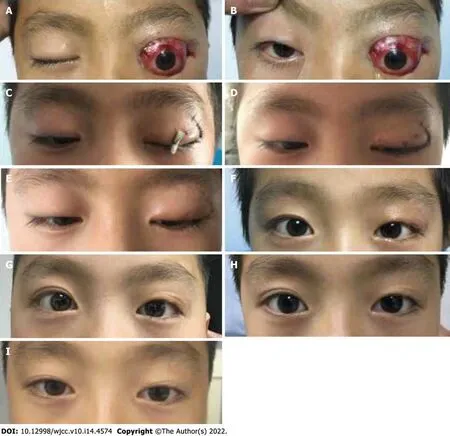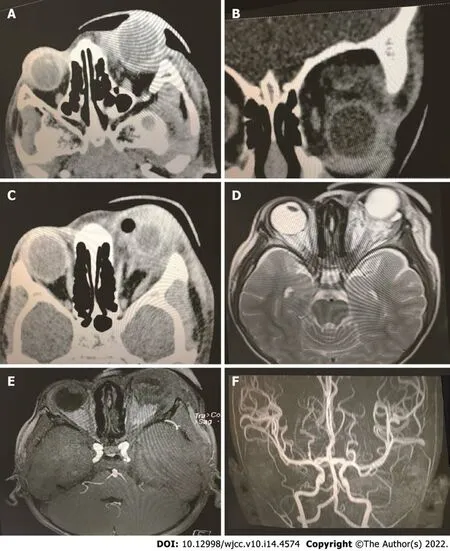Globe luxation may prevent myopia in a child: A case report
lNTRODUCTlON
Luxation of the globe is a rare event that results from severe trauma to the orbit that often causes orbital rim and wall fractures, and it is sometimes accompanied by optic nerve avulsion and extraocular muscle (EOM) rupture. Most of these patients present impaired vision and restricted movement of the injured eyeball, even after the globe is repositioned. Herein, we report of a case of a 6-year-old boy who solely suffered left globe luxation, without any injury to the orbital bones or the maxillofacial structures. He achieved complete visual functional recovery and good cosmesis. However, after 4 years of follow-up, we were surprised to learn that the vision of his injured eye was better than that of the other eye, and his left eye maintained good eyesight, whereas the right eye was nearsighted.
CASE PRESENTATlON
Chief complaints
A 6-year-old child was admitted to the Eye Department of the Second Affiliated Hospital of Anhui Medical University (on June 3, 2017) with a complaint of ocular proptosis and no light perception after his tricycle had come to a sudden stop.
History of present illness
He was admitted to our department 4 h after the left eyeball was dislocated without any other facial injury after his tricycle had come to a sudden stop. He had pain in his left eye and experienced no light perception; moreover, his extraocular motility was limited.
History of past illness
The child and his grandfather denied any other medical conditions.
His second grade teacher wrote, Teddy is an excellent student, well liked by his classmates, but he is troubled because his mother has a terminal illness and life at home must be a struggle.
Personal and family history
The child and his grandfather denied any family history of related diseases.
Physical examination
Upon clinical examination, the patient presented with intact left globe luxation, exophthalmos (L/R = 5 mm), no visual acuity, no perception of light and a complete limitation of extraocular motility in all directions. The eyelid was intact, the conjunctiva showed hyperaemia, the cornea was dry and completely exposed and the pupil was mid-dilated, with no reaction to light (Figure 1A and B). Furthermore, he could not keep his right eye open.

Laboratory examinations
No laboratory tests.
Then she seized Hansel with her bony hand and carried him into a little stable, and barred the door on him; he might scream as much as he liked, it did him no good
Imaging examinations
Computed tomography and magnetic resonance imaging showed proptosis of the left globe and gas accumulation in the superior intraconal space and stretching of the EOM (Figure 2A-E). Magnetic resonance angiography excluded carotid cavernous fistula (Figure 2F).
His ocular signs were essentially normal when he left the hospital 8 d after the surgery (Figure 1D). His left globe was repositioned with slight ocular hyperaemia and vision recovery (R/L = 1.0/0.2). After 1 mo of postoperative follow-up, the vision of the left eye had improved to 1.0, without restricted ocular movement and no signs of infection (Figure 1E). The patient has undergone 48 mo of follow-up, with satisfactory cosmetic and functional results. However, the visual acuity of his right eye was 0.2 due to nearsightedness (optometry: spherical equivalent of 1.25 D), and the axes of his eyes were oculus dexter: 23.66 mm and oculus sinister: 23.24 mm (measured on June 4, 2021) (Figure 1).

FlNAL DlAGNOSlS
But on the way they stayed at the court of a king, and it happened that he was holding games, and giving prizes to the best runners, boxers37, and quoit-throwers
TREATMENT
This article is an open-access article that was selected by an in-house editor and fully peer-reviewed by external reviewers. It is distributed in accordance with the Creative Commons Attribution NonCommercial (CC BYNC 4.0) license, which permits others to distribute, remix, adapt, build upon this work non-commercially, and license their derivative works on different terms, provided the original work is properly cited and the use is noncommercial. See: https://creativecommons.org/Licenses/by-nc/4.0/
OUTCOME AND FOLLOW-UP
6.Father: The father has an excellent excuse for not protecting his daughter in this tale--he s dead. Other fairy tale heroines suffer from ineffective fathers, such as in Hansel and Gretel and Rumpelstiltskin. Return to place in story.
DlSCUSSlON
Globe luxation rarely occurs and is often caused by direct orbital trauma with fractures of the medial and floor walls displacing the globe into the paranasal sinuses[1]. In our case, the boy experienced globe luxation when his tricycle stopped suddenly and did not have any other facial injuries. He did not remember whether he hit his head on any hard surfaces, such as the handlebar; thus, we believed that his globe luxation may have been caused by a sudden deceleration force while the eye maintained a high speed, which caused the orbit to stop suddenly after hitting a hard object of the tricycle. We found it interesting that globe luxation is often caused by severe trauma, which leads to severe orbital fractures and intraconal retrobulbar haematoma; however, the injured eye of this boy completely recovered, and the vision of the injured eye remained at 1.0, whereas the other eye was nearsighted. In this case, the pathogenesis, outcome and prognosis of globe luxation requires further study and discussion.
Globe luxation is often accompanied by different degrees of optic nerve avulsion, which is associated with prognosis[2]. In this case, the boy kept his optic nerve intact and completely recovered his visual acuity, which was consistent with the cases reported by Ramstead[3] and Müller-Richter[4]. It can be concluded that patients with globe luxation (but without optic nerve avulsion) have an increased possibility of achieving complete visual recovery. Moreover, immediate surgical management must be emphasized; once the possibility of other diseases is ruled out, every attempt should be made to anatomically reposition a displaced globe as soon as possible[5]. Treatment delays will increase the risk of complications, such as oedema and strain on the optic nerve and central retinal artery over time, especially in those patients with optic nerve avulsion[6].
The authors declare that they have no conflicts of interest.
Combined with the clinical and imaging examination, the final diagnosis was globe luxation.
CONCLUSlON
Consent was obtained from parents of the patients for publication of this report.
FOOTNOTES
The contributions of authors are the same.
She listened to my reasons why not and simply said, I want to do it. I agreed. And in the next few days, Sonali s repertoire18 of mostly Disney tunes19 expanded to include a beautiful prayer from the Rig Veda that we heard at the Siddha Yoga Meditation20 Ashram in New York where we were staying. Clearly, Let Us Be United was the perfect song for Sonali to sing:
Key Research and Development Projects of Science and Technology Department of Anhui Province, No. 201904d07020003.
In our case, globe luxation was not as severe as what has been previously reported, and luxation occurred when the boy’s tricycle stopped suddenly. The boy maintained an intact retinal nerve and EOM and completely recovered after eye repositioning. According to this case, we believe that immediate surgical management must be performed, especially for patients with retinal nerves that are not severely injured. In addition, we hypothesize that there may exist some correlation between globe luxation and myopia; globe luxation may prevent nearsightedness by reducing the distortion of the eyeball and improving ciliary function.
When globe luxation occurs, the EOM can be injured as well, depending on the degree of trauma. The medial rectus is most commonly affected, followed by the inferior rectus, which often severely restricts eyeball movement[7]. Luckily, in our case, the EOM of the boy was only stretched. After globe repositioning, there was no proof of EOM injury; the movements of the globe were not restricted to any degree in any direction, and his eye function consistently remained good. After four years of follow-up, the visual acuity in the injured eye remained at 1.0, whereas the right eye had unexpected myopia. We are unsure how this result occurred. Myopic development is associated with stress imposed on the globe by the lids and EOM. Extraocular muscle forces may temporarily distort the eyeball; over time, such distortion may become permanent and lead to myopia[8,9]. Moreover, Li[10] demonstrated that the development of staphyloma in patients with a high degree of myopia is related to EOM displacement. Therefore, we may reasonably infer that after the EOM was stretched, its flexibility was decreased, which may reduce the stress imposed on the eyeball by the EOM, thereby reducing the distortion to some degree. Furthermore, the ciliary muscle plays an important role in regulating the lens; after luxation, the blood circulation in the ciliary may be changed, which may have a relaxing effect in the ciliary, thus reducing the incidence of myopia[11]. Of course, we cannot exclude that the boy may have taken more care of the left eye after it was injured; however, we believe that the use of both eyes was equal. It may be possible that both eyes were myopic, but that one of them exhibited more severe myopia. However, it is difficult to understand why the injured eye consistently remained good, even though the other eye was myopic (spherical equivalent of 1.25D).
The authors have read the CARE Checklist (2016), and the manuscript was prepared and revised according to the CARE Checklist (2016).
One day after admission, the patient was transferred to an operating room to treat the ocular lesions, and an external canthus incision, globe repositioning, orbital exploration and temporary blepharoplasty were performed. The eyeball was pressure bandaged for the next 48 h. Seven days later, the eyelid suture was removed.
China
Yu-Xin Xu 0000-0001-7138-4265.
37. Ancient dame leaning on a staff: The woman has the appearance of a venerable grandmother or village wise woman. The children are placated102 by her harmless appearance.Return to place in story.
Yan JP
At the end of this time he had fallen in love with a charming Princess, but that when he had shut himself up into a room with her, and had thrown off his snake s skin, her parents had forced their way into the room and had burnt the skin, whereupon the Prince, changed into the likeness29 of a dove, had broken a pane of glass in trying to fly out of the window, and had wounded himself so badly that the doctors despaired of his life
A
Yan JP
 World Journal of Clinical Cases2022年14期
World Journal of Clinical Cases2022年14期
- World Journal of Clinical Cases的其它文章
- Perfectionism and mental health problems: Limitations and directions for future research
- Ovarian growing teratoma syndrome with multiple metastases in the abdominal cavity and liver: A case report
- Development of plasma cell dyscrasias in a patient with chronic myeloid leukemia: A case report
- Suprasellar cistern tuberculoma presenting as unilateral ocular motility disorder and ptosis: A case report
- Rare pattern of Maisonneuve fracture: A case report
- PD-1 inhibitor in combination with fruquintinib therapy for initial unresectable colorectal cancer: A case report
